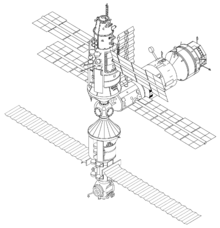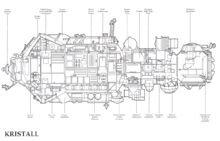Crystal (me)
| Mission dates | |
|---|---|
| Mission: | crystal |
| Crew: | unmanned |
| Target: | Me |
| Start vehicle: | proton |
| Start on: | May 31, 1990 / Baikonur |
| Coupling on: | June 10, 1990 |
| Decoupling on: | - |
| Re-entry on: | March 23, 2001 |
| Flight duration: | 3,948 days |
| burns up over: | Pacific |
| Earth orbits: | around 63,800 |
|
previous DCS mission : |
following DCS mission : |
Crystal is the name of a scientific module that was docked on the Soviet Mir space station . (The still common name Kwant-3 is not officially used.)
development
Crystal weighed around 20 tons in its original configuration and was launched into space on May 31, 1990 on board a Proton K rocket in Baikonur . After a long autonomous flight to test the systems, the module was successfully docked on June 10, 1990 at the first attempt at the axial port of the coupling socket of the Mir space station . After docking, Kristall was moved with the help of a robotic arm to the radial docking point opposite the Kwant 2 module that was already docked . Crystal was the third module to expand the space station. The over 60 cubic meters of pressurized room in the module were mainly intended for biological and materials science experiments. In addition to the equipment for these experiments, the module , which was developed on the basis of a TKS ferry , had two enlarged solar sails with a total area of around 70 square meters and its own attitude control engines.
As a special feature, instead of the Merkur landing capsule, a coupling node with two androgynous docking points of the type APAS 89 (89 for the development year) was located at the rear end , which represented a further development of the APAS 75 docking device of the Apollo-Soyuz project . This system - unlike common coupling systems - enabled any spacecraft equipped with it to take over both the passive and the active part of a docking maneuver. The new docking system was developed to enable the Buran space shuttle to dock with the Mir space station. At the same time, special Soyuz spaceships were to be equipped with this coupling system in order to serve as a rescue system for the Buran during manned test missions. In addition, modules were planned to expand the Mir with an APAS docking system, which should be attached to Kristall.
mission
Although the crystal module was originally intended for the coupling of Buran space shuttles, such a coupling could never take place. After the collapse of the Soviet Union, the Buran program was stopped for financial reasons in 1992 after an unmanned test flight. Manned flights from the Buran to Mir were therefore never realized. From the Buran program, a single, already built Soyuz rescue spaceship with the APAS docking system remained, which was used in January 1993 to transport a regular crew to Mir ( Soyuz TM-16 ). This remained the only Soyuz mission in Mir history that was not docked to the axial docking points of the Mir base module or the Kwant module.
In order to enable the further expansion of the Mir, one of the two large solar systems from Kristall to Kwant was moved back in 1992. Crystal itself was moved due to delays in the production of the next module in May 1995 by 90 ° to a radial docking of the coupling adapter Mir to provide enough space for the docking of the module Spektr create. Due to the increasing rapprochement between American and Russian space travel, consideration was given to using the crystal module to dock the American space shuttle . However, since this, due to its size, threatened to touch the Kwant-2 and Spektr modules, or at least their superstructures, or to damage them with ignition of the control engines, the complicated transfer of the module to the axial port of the Mir coupling adapter had to be carried out again. During the third Shuttle-Mir mission STS-71 first docked the space shuttle Atlantis to the NASA on June 29, 1995 on Crystal. (During the pre-mission, the Mir was only flown around and the approach maneuver tested; on the first mission of the program, the Mir was not flown to.) The mission was followed by moving the crystal back to its original position. As part of the fourth Shuttle-Mir mission, a special shuttle docking module (SDM) was attached to Kristall in order to offer the space shuttle a better docking option and to avoid the complex implementation of the subsequent missions. There were a total of nine shuttle missions to Mir, during which the docking maneuver always took place at Kristall or the SDM. After around 11 years in space, Kristall and the other modules of the Mir complex crashed in a controlled manner on March 23, 2001 over the Pacific.
Scientific tasks
Mainly new technology was tested with crystal, mainly for docking heavy space vehicles. The further developed coupling systems of the type APAS 89 were tested on crystal for the first time. The additional radial docking point was intended for the installation of a large space X-ray telescope, which was to be delivered and docked as part of the first Buran-Mir mission. After the Buran program was discontinued, however, this could not be realized, so that the radial docking point remained unused until the end of the Mir.
Furthermore, crystal was used for research in the fields of biology, geology and astrophysics. In the so-called "Swetlana" experiment, a greenhouse was operated to investigate the effects of weightlessness on plants. Other experiments dealt with the cultivation or formation of crystals in weightlessness. A telescope , a spectrometer as well as photographic equipment and other devices for astrophysical observations were also located in the module and on the outer wall .
Conclusions
Crystal played an important role in the cooperation between American and Russian space travel. For the first time since the Apollo-Soyuz mission , unique couplings of spacecraft from different nations took place on Kristall. Furthermore, spacecraft of large mass were coupled together for the first time and a record weight for space complexes was achieved ( around 220 tons on the first Shuttle Mir mission , later even more ). In addition, crews of up to 13 people met in a space station for the first time. In this context, the technology for international missions was substantially modified and made mutually available to the nations. The androgynous APAS coupling system, which is still in use today, is fundamentally based on the use of the crystal module. Furthermore, the Kristall expansion module SDM was the first internationally built space station module . Thus, with the aid of the crystal module, important knowledge was collected within the framework of the Mir program and equipment for the operation of today's international space station ISS was developed. As an aside, it should be mentioned that the joint space program has contributed significantly to the political rapprochement of the formerly hostile nations involved.
swell
- Harland, David M .; The story of Space Station Mir , Springer-Verlag, Berlin Heidelberg, New York 2005, ISBN 0-387-23011-4
Web links
- The modules of the MIR space station ( Memento from July 31, 2002 in the Internet Archive )





